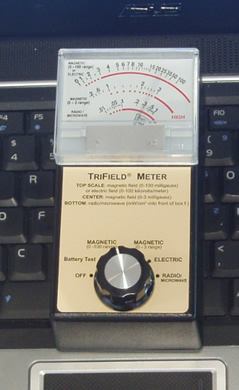Using the Trifield Gauss Meter
Trifield Gauss Meter
 Depending on where the knob is set, the meter detects either frequency- weighted magnetic fields (two separate scales), or frequency-weighted electric fields in the ELF and VLF range. It has significant sensitivity at 100,000 Hz, well past the 17,000 Hz horizontal scan of video displays. The radio/microwave setting can detect up to three billion Hz (3 GHz), which lets you gauge radio- wave power, CB and cellular phone equipment, and many types of radars.
Depending on where the knob is set, the meter detects either frequency- weighted magnetic fields (two separate scales), or frequency-weighted electric fields in the ELF and VLF range. It has significant sensitivity at 100,000 Hz, well past the 17,000 Hz horizontal scan of video displays. The radio/microwave setting can detect up to three billion Hz (3 GHz), which lets you gauge radio- wave power, CB and cellular phone equipment, and many types of radars.
This meter is the only one which combines magnetic, electric, and radio/microwave detectors in one package, so that the entire nonionizing electromagnetic spectrum is covered. In addition, the magnetic setting and the electric setting measure true magnitude, a feature found elsewhere only in more expensive meters. If you hold the meter in the center of a room and tip it to various angles, the magnetic reading will stay approximately the same regardless of which way you tip or rotate it. The electric reading is similar, although the presence of your body alters the actual electric field, so readings will vary more. The radio/microwave setting reads the full power of radiowaves when the meter is pointed toward the source.
Surprisingly, the standard TriField Meter is one of the least expensive meters available. The few other meters below $200 read only low-frequency magnetic fields and only in one direction (not true magnitude). The magnetic section of the TriField meter has three field-detecting coils pointing in the X, Y, and Z directions. A circuit amplifies these signals and gives them the proper frequency-weighting (sensitivity increases linearly from 30 Hz to 500 Hz, but with some residual sensitivity up to 100 kHz). A unique network combines the three coil outputs nonlinearly to approximate a true magnitude. The meter is sensitive from 0.2 to 100 milligauss full scale at 60 Hz (or 0.1 to 50 milligauss full scale at 120 Hz, etc.) with a resolution of 0.2 milligauss in the sensitive range. Accuracy is +/-20% at mid-range. A version with flat frequency response (instead of linear sensitivity increase) is also available for the same price.
The TriField Meter comes with a 9-volt transistor battery included. This type of battery lasts about 10 hours (total measurement time). When the BATTERY TEST reads low, the battery can be replaced with any rectangular 9 volt transistor or alkaline (which lasts about 50 hours) type. This meter is manufactured in the USA. TriField is a registered trademark of W.B. Lee.
Using the Trifield Gauss Meter
A knob on the front has six positions: OFF, BATTERY TEST, two MAGNETIC field sensitivities (0.5-100 milligauss at 60 Hz, and 0.2-3 milligauss at 60 Hz, the second sensitivity to measure weak fields more accurately), ELECTRIC field and RADIO/MICROWAVE power density. The meter face is analog (needle type). A needle reading of one-third of full scale corresponds to either 3 milligauss (or 0.6 milligauss) @ 60 Hz, 3 kilovolts/meter @ 60 Hz, or 0.04 mW/cm2 respectively in the magnetic, electric, and radio/microwave field settings. Average magnetic field strength in North American homes and offices is 1-3 milligauss, so the meter is labeled "HIGH" above these levels.
Magnetic Field Detection
In most homes or offices, some areas are "hot" spots with readings in the HIGH range. Most often, this is caused by magnetic fields, which come largely from unpaired internal wiring. (Contrary to popular belief, power transmission lines and transformers do not generally contribute as much magnetic field as does internal wiring.) Other magnetic sources include video displays, motorized clocks and other equipment, electric blankets and heaters, fluorescent lights and light dimmers, and the transformers that are inside consumer devices. Much of the total field strength is from frequencies that are harmonics or multiples of 60 Hz (120 Hz, 180 Hz, etc.) and 17,000 Hz of video displays. Cars (especially near the front floorboard of electronic ignition cars) and motorcycles have fairly strong fields that are at frequencies higher than 60 Hz. Magnetic field is difficult to shield, but sheet steel is somewhat effective.
Electric Field Detection
A few areas in most homes read HIGH in the electric field setting. These include areas near improperly grounded equipment, the front of video screens, and fluorescent lights. Most of these fields can be easily shielded using a grounded metal screen or foil; VDT screens of this type are readily available. You can greatly reduce the strength of an electric field just by placing your hand in front of the source. This effect can be seen using a TriField meter.
Microwave Detection
Occasionally, certain areas read HIGH in the radio/microwave setting. These include door seals around microwave ovens, and cellular phones (but not regular radio phones, which are very low-power). Radio/microwaves can be shielded in the same way as electric fields, although the lower frequency radio waves are not shielded by your hand as easily as microwaves are. (Metal screens will shield both.) In the United States, radars and FM transmitters can legally expose residents to moderately high power levels (as high as 10 mW/cm2 briefly or .57 mW/cm2 near cellular towers), but such exposure is not common.
Reducing Field Exposure
Some equipment is sensitive to magnetic fields (ie, a high resolution color monitor may not function properly above 30 milligauss). By seeing "hot" spots in your home and office, you can move equipment or furniture to reduce exposure. If a room has a "hot" spot, fields are generally much weaker elsewhere in that same room.
